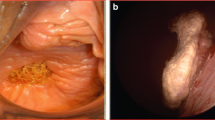Abstract
This case series’ purpose is to review a referral center’s experience with complications from mesh kits. A chart review of 12 patients who presented with complications associated with transvaginal mesh kit procedures was performed. All patients underwent complete surgical removal of the mesh to treat mesh exposure, pain, or vaginal bleeding/discharge followed by an anterior or posterior repair. The mean follow-up time after surgery was 3.4 months. Eight of 12 patients had mesh that had formed a fibrotic band. Six of 12 patients had complete resolution of pain. Of the nine patients with mesh exposure, all required significant resection of the vaginal wall. No further mesh exposure occurred. The use of transvaginal mesh kits may cause previously undescribed complications such as pelvic/vaginal pain or large extrusions requiring complete removal. Removal of all mesh except the arms may cure or significantly improve these problems.

Similar content being viewed by others
References
Olsen AL, Smith VJ, Bergstrom JO (1997) Epidemiology of surgically managed pelvic organ prolapse and urinary incontinence. Obstet Gynecol 89:501–506
Maher C, Baessler K (2006) Surgical management of anterior vaginal wall prolapse: an evidence based literature review. Int Urogynecol J 17:195–201
Maher C, Baessler K (2005) Surgical management of posterior vaginal wall prolapse: an evidence-based literature review. Int Urogynecol J 17:84–88
Weber AM, Walters MD, Piedmonte MR, Ballard LA (2001) Anterior colporrhaphy: a randomized trial of three surgical techniques. Am J Obstet Gynecol 185:1299–1306
Sand PK, Koduri S, Lobel RW, Winkler HA, Tomezsko J, Culligan PJ et al (2001) Prospective randomized trial of polyglactin 910 mesh to prevent recurrence of cystoceles and rectoceles. Obstet Gynecol 184:1357–1364
Debodinance P, Berrocal J, Clavé H, Cosson M, Garbin O, Jacquetin B et al (2004) Changing attitudes on the surgical treatment of urogenital prolapse: birth of the tension-free vaginal mesh. J Gynecol Obstet Biol Reprod (Paris) 33(7):577–588
Gauruder-Burmester A, Koutouzidou P, Rohne J, Gronewold M, Tunn R (2007) Follow-up after polypropylene mesh repair of anterior and posterior compartments in patients with recurrent prolapse. Int Urogynecol J 18:1059–1064
Sentilhes L, Sergent F, Resch B, Verspyck E, Descamps P, Marpeau L (2007) Midterm follow-up of high-grade genital prolapse repair by the trans-obturator and infracoccygeal hammock procedure after hysterectomy. Eur Uro 51:1065–1072
Abdel-fattah M, Ramsay I, on behalf of the West of Scotland Study Group (2008) Retrospective multicentre study of the new minimally invasive mesh repair devices for pelvic organ prolapse. BJOG 115:22–30
Altman D, Falconer C, for the Nordic Transvaginal Mesh Group (2007) Perioperative morbidity using transvaginal mesh in pelvic organ prolapse repair. Obstet Gynecol 109:303–308
Fatton B, Amblard J, Debodinance P, Cosson M, Jacquetin B (2007) Transvaginal repair of genital prolapse: preliminary results of a new tension-free vaginal mesh (Prolift™ technique)—a case series multicentric study. Int Urogynecol J 18:743–752
Culligan PJ, Blackwell L, Goldsmith LJ, Graham CA, Rogers A, Heit M (2005) A randomized controlled trial comparing fascia lata and synthetic mesh for sacral colpopexy. Obstet Gynecol 106:29–37
Diokno AC, Burgio K, Fulz NH, Kinchen KS, Obenchain R, Bump RC (2003) Prevalence and outcomes of continence surgery in community dwelling women. J Urol 170:507–511
Boyles SH, McCrery R (2008) Dyspareunia and mesh erosion after vaginal mesh placement with a kit procedure. Obstet Gynecol 111(4):969–975
Yamada BS, Govier FE, Stefanovic KB, Kobashi KC (2006) Vesicovaginal fistula and mesh erosion after Perigee (transobturator polypropylene mesh anterior repair). Urology 1121:e5–e7
Gangam N, Kanee A (2007) Retroperitoneal hemorrhage after vaginal mesh prolapse procedure. Obstet Gynecol 110:463–464
Mokrzycki ML, Hampton BS (2007) Pelvic artery embolization in the setting of acute hemorrhage as a result of the anterior Prolift® procedure. Int Urogynecol J 18:813–815
Ignjatovic I, Stosic D (2007) Retrovesical hematoma after anterior Prolift® procedure for cystocele correction. Int Urogynecol J 18:1495–1497
LaSala CA, Schimpf MO (2007) Occurrence of postoperative hematomas after prolapse repair using a mesh augmentation system. Obstet Gynecol 109:569–572
Milani R, Salvatore S, Soligo M, Pirarotti P, Meshia M, Cortese M (2005) Functional and anatomical outcome of anterior and posterior vaginal prolapse repair with Prolene mesh. BJOG 112:107–111
Huffaker RK, Muir TW, Rao A, Baumann SS, Kuehl TJ, Pierce LM (2008) Histologic response of porcine collagen-coated and uncoated polypropylene grafts in a rabbit vagina model. Am J Obstet Gynecol 198:e1–e7
Achtari C, Hiscock R, O’Reilly BA, Schierlitz L, Dwyer PL (2005) Risk factors for mesh erosion after transvaginal surgery using polypropylene (atrium) or composite polypropylene/polyglactin 910 (Vypro II) mesh. Int Urogynecol J 16(5):389–394
de Tayrac R, Devoldere G, Renaudie J, Villard P, Guilbaud O, Eglin G: The French Ugytex Study Group (2007) Prolapse repair by vaginal route using a new protected low-weight polypropylene mesh: 1-year functional and anatomical outcome in a prospective multicentre study. Int Urogynecol J 18:251–256
Conflicts of interest
None.
Author information
Authors and Affiliations
Corresponding author
Rights and permissions
About this article
Cite this article
Hurtado, E.A., Appell, R.A. Management of complications arising from transvaginal mesh kit procedures: a tertiary referral center’s experience. Int Urogynecol J 20, 11–17 (2009). https://doi.org/10.1007/s00192-008-0721-9
Received:
Accepted:
Published:
Issue Date:
DOI: https://doi.org/10.1007/s00192-008-0721-9




